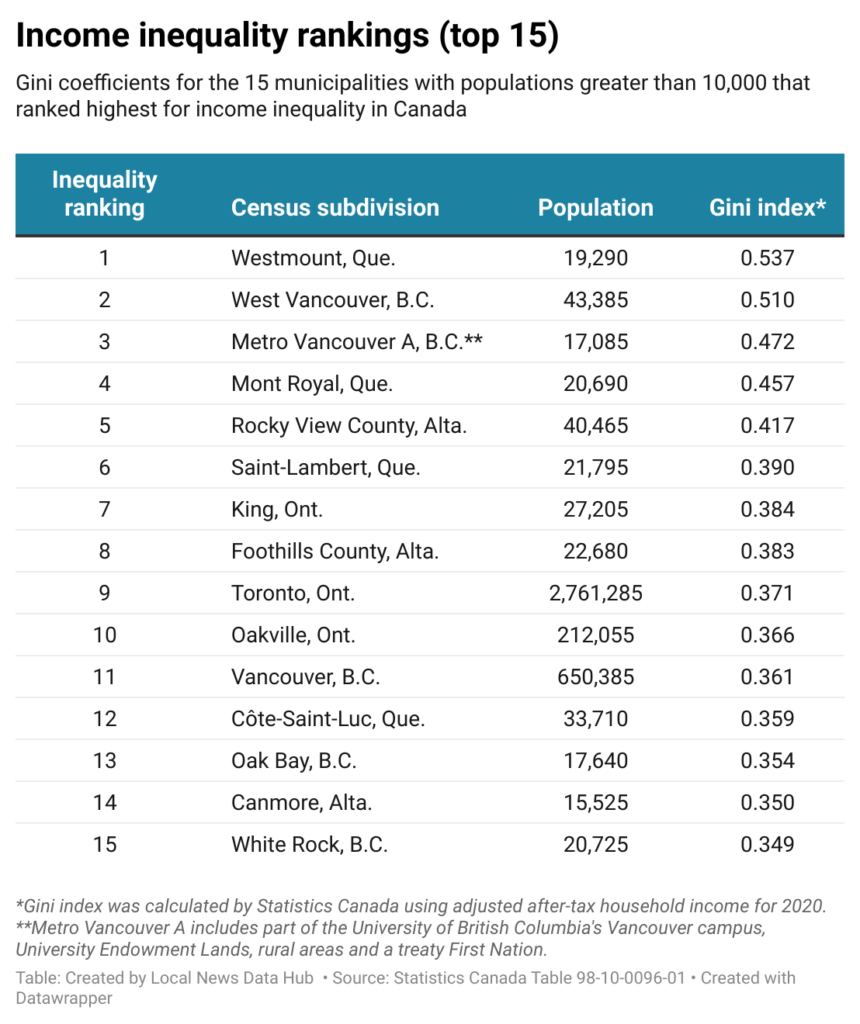
Calgary, Rocky View and Foothills rank high for income equality, new analysis shows
Local municipalities have some of the country’s widest gaps between high- and low-income residents

By Carly Penrose
Local News Data Hub
Sept. 21, 2023
Income inequality, known for its corrosive effects on health, happiness and community ties, is much worse in Calgary and two neighbouring counties than in most Canadian municipalities, according to a new analysis of Statistics Canada data.
Rocky View County ranked fifth in the country for income inequality on a national list assembled by the Local News Data Hub at Toronto Metropolitan University. Foothills County ranked eighth, while Calgary was 22nd.
Statistics, however, don’t capture what it is like to live on very little when others have so much.
Aimee Benoit, a University of Lethbridge alumna who studied the impact of income inequality on Calgary neighbourhoods as part of her PhD dissertation, said some residents she interviewed in the city’s low-income pockets told her they felt unwelcome in wealthier and more gentrified parts of the city, like gated communities and golf courses.
Many felt a sort of stigma as they were “excluded from community activities based on where they lived,” said Benoit, who is now a community heritage expert at Athabasca University.
In cities with a high degree of inequality, high- and low-income residents tend to “become socially isolated amongst people like themselves,” said Ivan Townshend, a social geographer at the University of Lethbridge.
People of different means have fewer opportunities to cross paths when neighbourhoods separate those who “have” from those who “have not,” Townshend said. The isolation makes it easier for rich and poor to form ideas about each other based on stereotypes and then blame the other group for social ills, he added.
Many racialized people and immigrants end up living in Calgary’s lowest-income areas, he said, and that adds to the challenges members of these groups face in building wealth and developing relationships across the larger community.
Income inequality has been linked to a reduced sense of community belonging, greater distrust among residents, more financial worries and increased anxiety about social status — outcomes all associated with lower levels of happiness and poorer mental and physical health. Research has also associated big income gaps with greater political polarization and increases in theft and vandalism fuelled by desperation and a sense of unfairness.
To compare income inequality across Canada, the Local News Data Hub ranked the country’s 418 municipalities with more than 10,000 people using Statistics Canada’s 2020 Gini index for adjusted after-tax household income.
The Gini index is an internationally recognized tool statisticians use to measure how income is distributed across a society. Income, in this case, takes into account wages, pension income, investment earnings such as dividends and interest, and government transfers like social assistance. The number 1 ranked municipality had the highest level of inequality.
The national ranking, which was reviewed by Statistics Canada senior research analyst Xuelin Zhang, points to significant variations among communities. For instance:
- There were major differences in income inequality among Canadian cities with more than 200,000 people. Toronto was ninth on the overall Gini ranking, Vancouver was 11th, and Montreal was 29th. Edmonton, however, was much further down the list, ranking 68th.
- The highest-earning 10 per cent of Edmonton households made 3.8 times more than the lowest earners. In more unequal cities like Toronto, the top group makes nearly five times as much as the lowest-earning group.
- The resort town of Canmore, Alta., placed 14th in the Gini ranking. The Alberta Living Wage Network released a report in 2022 showing that Canmore has the highest cost of living in the province. To cover expenses and thrive, local workers must earn at least $32.75 per hour.
- The widest gap between high- and low-income residents in Canada was in Westmount, Que., home to about 20,000 people. In Westmount’s richest neighbourhood the median household income is $360,000, according to data from the non-profit Centraide Montreal. The municipality, however, also includes people who live in extremely low-income neighbourhoods on its periphery. The highest-earning 10 per cent of households in Westmount made nearly 11 times more than the lowest earners in 2020.

In Rocky View County, a mostly rural area surrounding Calgary with many large ranches and lavish homes, the median after-tax household income is $126,000, well above the national median of $73,000.
Even so, 2,150 people, or 5.3 per cent of the population, live in poverty and it is often difficult for them to get help. Laura McDonald, executive director of Helping Hands Cochrane, said people in need are dispersed throughout the municipality, making it more challenging and costly to reach them with services.
Life in the county is expensive and its poorest residents are “surrounded by people who are really living their best lives,” said McDonald, whose grassroots organization provides help with everything from moving costs to travel expenses for medical and other appointments in Calgary.
Statistics Canada data show income inequality declined nationally between 2015 and 2020, largely due to the Canada Child Benefit introduced in 2016 and pandemic-related government transfers like the Canada Emergency Response Benefit (CERB). But David Macdonald, an economist at the Canadian Centre for Policy Alternatives in Ottawa, said inequality and poverty are expected to rise now that CERB payments have ended.
Macdonald also pointed out that the Gini measure tends to underestimate inequality because it is calculated based only on income data and doesn’t include inherited wealth, capital gains or non-financial assets like real estate. “If you include capital gains in the definition of income,” he added, “then you actually see income inequality grow.”
A recent Statistics Canada report illustrated Macdonald’s point. The wealthiest 20 per cent of households controlled two-thirds of the country’s net worth as of early 2023, the report says, while the bottom 40 per cent accounted for just 2.7 per cent. The report also noted that the wealth gap between rich and poor in Canada widened at the fastest pace on record in the first quarter of this year. Compared to the wealthiest households, lower-income Canadians accumulated more debt, saw their savings shrink and received less investment income.
Lee Stevens, a policy and research specialist at Calgary’s Enough for All, said investments in community housing, transit, libraries and recreation centres, as well as a fairer tax system could help reduce income gaps.
Labour organizations argue for increases in social assistance, a higher minimum wage and updated labour laws that reduce the number of precarious jobs and make it easier for workers to unionize.
Last year, Halifax Regional Council and the Union of BC Municipalities both passed resolutions calling for a federally funded guaranteed basic income.
This story was produced by the Local News Data Hub, a project of the Local News Research Project at Toronto Metropolitan University’s School of Journalism. The Canadian Press is the Data Hub’s operational partner. Detailed information on the data and methodology can be found here.